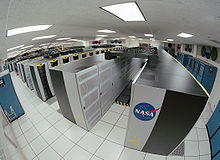A supercomputer is a computer that is at the frontline of current processing capacity, particularly speed of calculation. Supercomputers were introduced in the 1960s and were designed primarily by Seymour Cray at Control Data Corporation (CDC), which led the market into the 1970s until Cray left to form his own company, Cray Research. He then took over the supercomputer market with his new designs, holding the top spot in supercomputing for five years (1985–1990). In the 1980s a large number of smaller competitors entered the market, in parallel to the creation of the minicomputer market a decade earlier, but many of these disappeared in the mid-1990s "supercomputer market crash".
Today, supercomputers are typically one-of-a-kind custom designs produced by "traditional" companies such as Cray, IBM and Hewlett-Packard, who had purchased many of the 1980s companies to gain their experience. Since October 2010, the Tianhe-1A supercomputer has been the fastest in the world; it is located in China.
The term supercomputer itself is rather fluid, and the speed of today's supercomputers tends to become typical of tomorrow's ordinarycomputers. CDC's early machines were simply very fast scalar processors, some ten times the speed of the fastest machines offered by other companies. In the 1970s most supercomputers were dedicated to running a vector processor, and many of the newer players developed their own such processors at a lower price to enter the market. The early and mid-1980s saw machines with a modest number of vector processors working in parallel to become the standard. Typical numbers of processors were in the range of four to sixteen. In the later 1980s and 1990s, attention turned from vector processors to massive parallel processing systems with thousands of "ordinary" CPUs, some being off the shelf units and others being custom designs. Today, parallel designs are based on "off the shelf" server-class microprocessors, such as the PowerPC, Opteron, or Xeon, and coprocessors like NVIDIA Tesla GPGPUs, AMD GPUs, IBM Cell, FPGAs. Most modern supercomputers are now highly-tuned computer clusters using commodity processors combined with custom interconnects.
Supercomputers are used for highly calculation-intensive tasks such as problems involving quantum physics, weather forecasting, climate research, molecular modeling (computing the structures and properties of chemical compounds, biological macromolecules, polymers, and crystals), physical simulations (such as simulation of airplanes in wind tunnels, simulation of the detonation of nuclear weapons, and research into nuclear fusion).
Relevant here is the distinction between capability computing and capacity computing, as defined by Graham et al.Capability computing is typically thought of as using the maximum computing power to solve a large problem in the shortest amount of time. Often a capability system is able to solve a problem of a size or complexity that no other computer can. Capacity computing in contrast is typically thought of as using efficient cost-effective computing power to solve somewhat large problems or many small problems or to prepare for a run on a capability system.
Supercomputer challenges, technologies
- A supercomputer consumes large amounts of electrical power, almost all of which is converted into heat, requiring cooling. For example, Tianhe-1A consumes 4.04 Megawatts of electricity.The cost to power and cool the system is usually one of the factors that limit the scalability of the system. (For example, 4MW at $0.10/KWh is $400 an hour or about $3.5 million per year).
- Information cannot move faster than the speed of light between two parts of a supercomputer. For this reason, a supercomputer that is many meters across must have latencies between its components measured at least in the tens of nanoseconds. Seymour Cray's supercomputer designs attempted to keep cable runs as short as possible for this reason, hence the cylindrical shape of his Cray range of computers. In modern supercomputers built of many conventional CPUs running in parallel, latencies of 1–5 microseconds to send a message between CPUs are typical.
- Supercomputers consume and produce massive amounts of data in a very short period of time. According to Ken Batcher, "A supercomputer is a device for turning compute-bound problems into I/O-bound problems." Much work on external storage bandwidth is needed to ensure that this information can be transferred quickly and stored/retrieved correctly.
Technologies developed for supercomputers include:
- Vector processing
- Liquid cooling
- Non-Uniform Memory Access (NUMA)
- Striped disks (the first instance of what was later called RAID)
- Taken from:. http://en.wikipedia.org/wiki/Supercomputer






0 comments:
Post a Comment